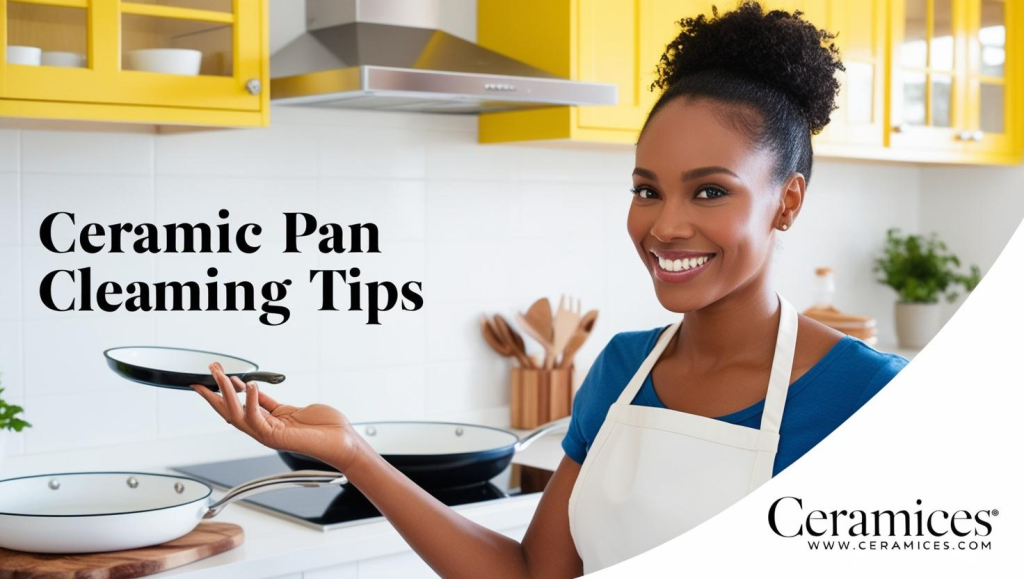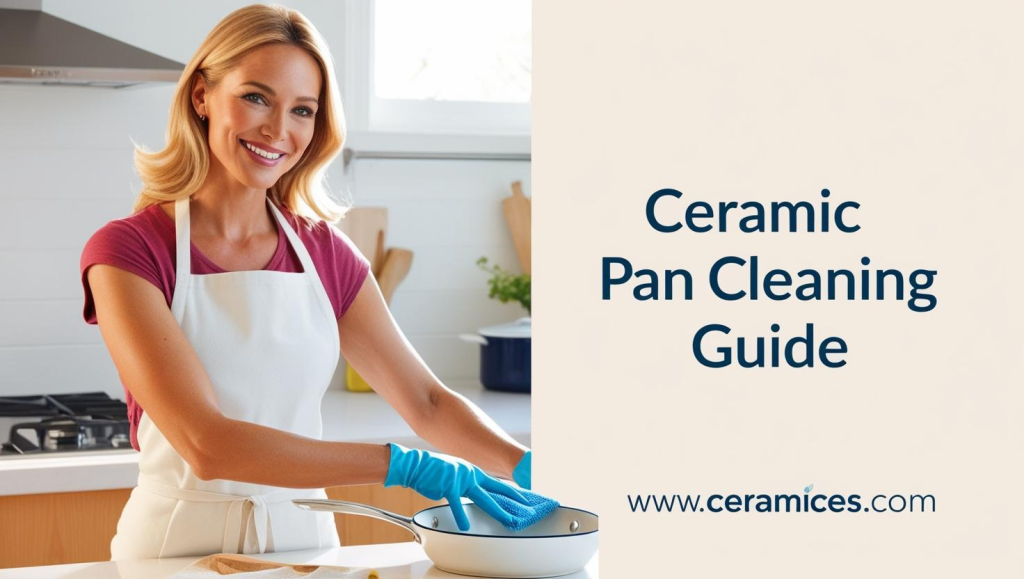Ceramic pans have become a kitchen staple for health-conscious home cooks, offering a safer alternative to traditional non-stick cookware. But many users quickly discover that keeping these pans in pristine condition requires special care. Learning how to clean a ceramic pan properly is essential to maintain its non-stick properties, prevent staining, and extend its lifespan.
This comprehensive 2,000-word guide provides detailed instructions for all aspects of ceramic pan maintenance. We’ll cover everything from daily cleaning routines to tackling tough stains, proper storage solutions, and troubleshooting common issues. Whether you’re a cooking novice or a seasoned chef, these expert techniques will help you keep your ceramic pans performing like new for years to come.
Why Proper Ceramic Pan Cleaning Matters
Ceramic-coated cookware offers numerous benefits that make proper cleaning essential:
Health Advantages:
- Free from PFOA, PTFE, lead, and cadmium found in some traditional non-stick pans
- Non-porous surface prevents bacterial growth
- Doesn’t release toxic fumes when overheated
Performance Benefits:
- Maintains non-stick properties longer when cleaned properly
- Prevents flavor transfer between foods
- Ensures even heat distribution
- Preserves the pan’s aesthetic appeal
Economic Value:
- Extends the lifespan of your investment
- Reduces need for frequent replacements
- Maintains resale value for high-end pieces
Neglecting proper cleaning can lead to:
- Permanent staining from oils and acidic foods
- Loss of non-stick performance
- Chipping or cracking of the ceramic coating
- Warping from thermal shock
- Bacterial growth in scratched areas
Daily Cleaning Routine for Ceramic Pans

Immediate Post-Cooking Care
- Cool Down: Allow pan to cool to warm (not cold) before cleaning
- Soak if Needed: For stuck-on food, add warm water and let sit 10-15 minutes
- Gentle Scrubbing: Use a soft sponge or nylon brush with mild detergent
- Thorough Rinsing: Remove all soap residue with warm water
- Complete Drying: Dry immediately with soft towel or air dry upside down
Recommended Cleaning Tools
- Sponges: Non-scratch cellulose sponges (blue Scotch-Brite recommended)
- Brushes: Nylon-bristle dish brushes
- Scrapers: Wooden or silicone pan scrapers for stubborn bits
- Cloths: Microfiber or 100% cotton towels
Products to Avoid
- Steel wool or metal scrubbers
- Abrasive cleansers (Comet, Bar Keepers Friend)
- Harsh degreasers
- Dishwasher detergent (for hand washing)
Deep Cleaning Methods for Tough Residue
Baking Soda Treatments
For general buildup:
- Make a paste with 3 tbsp baking soda + 1 tbsp water
- Apply to entire cooking surface
- Let sit 20-30 minutes
- Gently scrub with soft sponge
- Rinse thoroughly
For burnt-on food:
- Cover residue with baking soda
- Add 1/2 inch of water
- Bring to gentle simmer for 5 minutes
- Remove from heat and let cool
- Scrub gently and rinse
Vinegar Solutions
For mineral deposits:
- Mix 1 part white vinegar with 2 parts water
- Bring to simmer in pan for 3-5 minutes
- Cool slightly before scrubbing
- Rinse thoroughly
For oil buildup:
- Sprinkle baking soda in pan
- Spray with vinegar until foaming stops
- Scrub gently with soft brush
- Rinse completely
Salt Scrubs
For stubborn stains:
- Cover stain with coarse salt
- Add just enough water to make a paste
- Let sit 15 minutes
- Scrub gently in circular motions
- Rinse and dry completely
Special Considerations for Different Stains
Protein Stains (eggs, meat)
- Cause: Protein bonds strongly to ceramic
- Solution: Soak in cool soapy water first
- Prevention: Use adequate oil and proper cooking temps
Starchy Residue (pasta, potatoes)
- Cause: Starches gelatinize when cooled
- Solution: Soak in warm water before cleaning
- Prevention: Don’t let starchy foods dry in pan
Oil Polymerization
- Cause: Repeated heating of oils
- Solution: Baking soda/vinegar treatment
- Prevention: Wipe out excess oil after cooking
Discoloration
- Cause: High heat or acidic foods
- Solution: Vinegar boil followed by baking soda scrub
- Prevention: Cook acidic foods at lower temps
Dishwasher Cleaning: Risks and Alternatives

Why Dishwashers Damage Ceramic Pans
- Abrasive Detergents: Break down ceramic coating over time
- High Temperatures: Can cause micro-cracks in coating
- Harsh Spray Action: May chip edges over multiple washes
- Extended Soaking: Promotes oxidation of metal base
If You Must Use Dishwasher
- Use gentle cycle and mild detergent
- Place on top rack only
- Remove immediately after cycle ends
- Dry thoroughly by hand
- Limit to occasional cleaning only
Proper Drying and Storage Techniques
Drying Methods
- Towel Drying: Use lint-free cotton towels
- Air Drying: Place upside down on drying rack
- Oven Drying: 200°F for 10 minutes (ensure complete dryness)
- Avoid: Air drying right-side up (traps moisture)
Storage Solutions
For Stacking:
- Use pan protectors or felt liners between pans
- Place paper towels between nested pans
- Store lids separately when possible
For Hanging:
- Install sturdy pot rack
- Use S-hooks that support full weight
- Ensure adequate air circulation
For Drawer Storage:
- Line drawer with nonslip liner
- Organize by size to prevent shifting
- Consider vertical dividers for lids
Maintaining Non-Stick Performance
Re-seasoning Process
- Wash and dry pan completely
- Apply thin layer of high-smoke-point oil
- Heat gently on stovetop until shimmering
- Cool completely
- Wipe out excess oil
Recommended Oils:
- Avocado oil (smoke point 520°F)
- Grapeseed oil (smoke point 420°F)
- Refined coconut oil (smoke point 400°F)
Cooking Temperature Guidelines
- Low (200-300°F): Melting, simmering
- Medium (300-375°F): Most cooking tasks
- Medium-High (375-425°F): Searing (briefly)
- Never: High heat empty pan
Utensil Selection Guide
Recommended:
- Silicone
- Wood
- Bamboo
- Nylon
- Plastic
Avoid:
- Metal
- Sharp-edged tools
- Serrated utensils
When to Replace Your Ceramic Pan
Safety Indicators
- Deep Scratches: Exposing base metal
- Flaking Coating: Visible ceramic pieces
- Warping: More than 1/8″ deviation
- Persistent Odors: After thorough cleaning
Performance Indicators
- Food Sticking: Even with proper technique
- Uneven Cooking: Hot spots developing
- Discoloration: That won’t clean off
- Handle Looseness: That can’t be tightened
Frequently Asked Questions (FAQs)
1. Can I use baking soda every time I clean my ceramic pan?
While safe, daily use isn’t necessary. Reserve baking soda for weekly deep cleaning or tough stains.
2. Why does my ceramic pan have rainbow-colored stains?
This “oil rainbow” effect comes from thin oil films. A vinegar rinse or degreasing soap will remove it.
3. How do I remove tomato sauce stains from my ceramic pan?
Create a paste of baking soda and hydrogen peroxide, apply for 15 minutes, then gently scrub.
4. Is it safe to use scratched ceramic pans?
Small surface scratches are generally safe, but deep scratches exposing the base metal may warrant replacement.
5. Can I use ceramic pans on induction stovetops?
Only if specifically marked as induction-compatible. Most ceramic pans require an induction disk.
6. What’s the best way to clean ceramic pan exteriors?
Use the same gentle methods as the interior. For discolored bottoms, try a paste of cream of tartar and water.
7. How do I prevent food from sticking to my ceramic pan?
Use proper preheating (1-2 minutes on medium), adequate oil, and allow food to release naturally before flipping.
8. Why does my ceramic pan smoke during cooking?
This is usually from oil breaking down. Use oils with higher smoke points and avoid overheating.
9. Can I repair a chipped ceramic pan?
No, chips cannot be safely repaired. Replace chipped pans, especially if ceramic is flaking.
10. How often should I replace my ceramic pans?
With proper care, quality ceramic pans last 2-5 years. Replace when non-stick performance declines significantly.
Conclusion: Mastering Ceramic Pan Maintenance
Proper ceramic pan cleaning and care ensures you’ll enjoy the benefits of this innovative cookware for years. By following these guidelines:
- Clean gently after each use with non-abrasive tools
- Deep clean weekly with baking soda or vinegar solutions
- Dry thoroughly before storing
- Store properly to prevent scratches
- Re-season occasionally to maintain non-stick properties
- Cook at proper temps with suitable utensils
- Recognize when to replace worn pans
Investing time in proper ceramic pan maintenance pays dividends in cooking performance, food safety, and long-term savings. With this comprehensive guide, you’re equipped to keep your ceramic cookware looking and performing its best through countless meals to come. Happy cooking!
Read more cleaning posts
1. Tricks to clean the glass ceramic
2. Best way to clean a ceramic stove